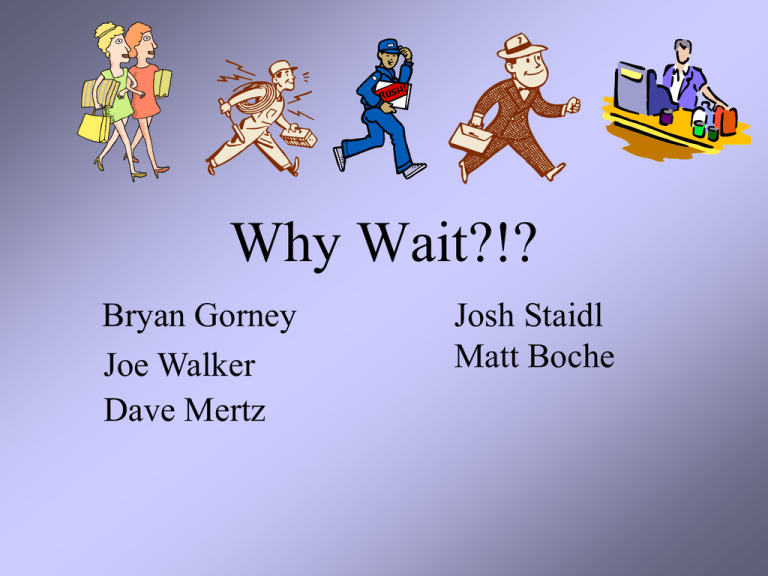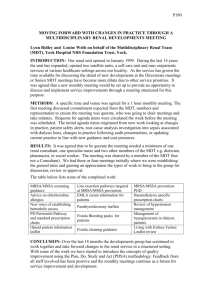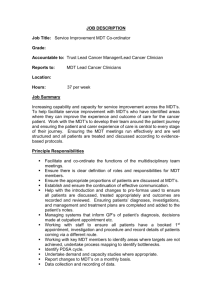Why Wait?!? Bryan Gorney Josh Staidl Matt Boche
advertisement

Why Wait?!?
Bryan Gorney
Joe Walker
Dave Mertz
Josh Staidl
Matt Boche
Purpose:
To minimize costs of businesses with waiting
lines, taking into consideration the cost of
servers and the long-run loss of revenue by
making customers wait too long.
Outline:
I.
Rudiments of Queuing Theory
a. 1 Customer, 1 Server
b. Many Customer, No Server
c. Many Customers, 1 Server
II. Concept of a Stationary Distribution
III. Traffic Intensity
a. Average Queue Length
b. Little’s Principle
c. Average Waiting Time
IV. Store Profit Maximization
1 Customer, 1 Server
•
•
•
•
N(t) = number of individuals at checkout counter at time t.
N(t) has only two possible values of 0 or 1.
“being served” corresponds to N(t) = 1.
“finished being served” corresponds to N(t) = 0.
To obtain the time-dependent transition probabilities for
this Markov chain, let
Xt =
( )
p(t)
q(t)
be the time-dependent distribution vector for the states
“being served” and “finished being served”.
That is,
p(t) = P[N(t) = 1]
and
q(t) = P[N(t) = 0]
• q(t) = 1 – p(t)
• lim p(t) = 0
t
lim Xt =
t
()
0
1
State diagram
mDt
1
0
1 - mDt
P[service is completed in Dt] = mDt
P[service is not completed in Dt] = 1 – mDt
1
The transition matrix for each Dt time step is given by
A=
(
1 – mDt 0
mDt
1
)
Thus,
Xt+Dt = AXt
which in matrix form gives:
(
p(t + Dt)
q(t + Dt)
) =(
1 – mDt 0
mDt
)( )
1
p(t)
q(t)
Performing matrix multiplication yields:
p(t + Dt) = (1 – mDt)p(t)
Rearranging so difference quotient is on the left-hand side:
p(t + Dt) – p(t)
Dt
=
-mp(t)
By letting Dt go to zero, the difference quotient becomes a
derivative, and
p’(t) = lim
Dt
0
p(t + Dt) – p(t)
Dt
= -mp(t)
This is the exponential differential equation with solution:
p(t) = P[N(t) = 1] = p0e-mt
Since we assumed that there is an individual initially being
served, N(0) = 1. This implies that p(0) = 1 which gives
p0 = 1. Finally we have:
p(t) = P[N(t) = 1] = e-mt
Since q(t) = 1 – p(t), the probability of completing the
service is:
q(t) = 1 – e-mt
• Next let T denote the time at which service is completed.
It is considered to be the time until transition from one
state to another.
• T is a continuous random variable with range 0 < T < .
• P[T > t] = P[N(t) = 1].
• P[T < t] = 1 – e-mt (complement).
• Left-hand side = cumulative distribution function of the
continuous random variable T.
• Right-hand side = exponential distribution.
P[T > s + t given T > s] = P[T > t] (Memoryless property)
for all s,t > 0.
Density function is the derivative of the cumulative
distribution which is:
f(t) = d P[T < t] = me-mt, 0 < t < .
dt
E(T) = tf(t)dt = tme-mtdt = 1m
0
0
Thus the average value of T is
rate m as:
m=
1
m
. We interpret the service
1
Mean Time Until Transition
Many Customers, No Server
Let N(t) be a time dependent function that denotes the number
of customer arrivals in a given interval [0,t], and assume the
following:
1. The probability that an arrival occurs in a short interval
[t, t+Dt] is proportional to the length of the interval Dt.
In symbols:
P[ N(t+Dt) - N(t) = 1] = Dt
for some constant >0.
2. The Memoryless Property:
The probability that an arrival occurs in [t, t+Dt] does
not depend on the time of previous arrivals:
P[ N(t+Dt) – N(t) = n | N(s) = m ] = P[ N(t+Dt) – N(t) = n]
for all 0 s t.
3. Occurrences of arrivals in non-overlapping intervals are
independent.
4. The Probability of two or more arrivals in [t, t+Dt] is negligible.
Assume Pn(t) = P[N(t) = n]
N(t) has possible values 0,1,2,… since it is possible
to have any number of customers in line.
Considering a time step of size Dt, N(t) forms a Markov
Chain, with a transition matrix of:
A=
(
1-Dt
0
0
0...
Dt 1-Dt
0
0...
0
Dt 1- Dt 0 . . .
)
State Diagram of Transition Matrix
Dt
1-Dt
Dt
1-Dt
Dt
1-Dt
Xt+Dt = AXt is the state equation for each time step
size Dt, where:
Xt =
P0(t)
P1(t)
:
Pn(t)
:
( )
After Matrix Multiplication: we have the following
system of equations:
P0(t+Dt) = (1-Dt)P0(t)
P1(t+Dt) = DtP0(t)+(1-Dt)P1(t)
Pn(t+Dt) = DtPn-1(t)+(1-Dt)Pn(t)
These equations can then be rearranged to make
difference quotients.
Letting Dt go to zero we obtain a system of differential
equations. For n 1,
Pn’(t) =
Pn(t+ Dt) – Pn(t)
limDt0
Dt
= [Pn-1(t) – Pn(t)],
and for n = 0,
P0’(t) = -P0(t)
This equation is the exponential differential
equation with initial condition that there are
no arrivals (P0(0) = 1). This gives:
P0(t) = e-t
Similarly, letting n=1,
P1’(t) = [P0(t)- P1(t)]
= [e-t - P1(t)]
This is a first-order linear differential equation
which can be solved by multiplying by the
integrating factor et.
d
[etP1(t)] = so that etP1(t) = t+c
dt
The initial condition P0(0) =1 implies Pn(0) = 0
for all n 1, thus:
P1(t) = te-t
It can be shown by induction that the system of
differential equations has solution:
Pn(t) = e-t(t)n
n!
for t0, n = 0,1,2,…
•Known as a homogeneous Poisson process
with rate . ( does not depend on time variable
t)
•Mean is t (t customers during time interval
of length t)
Ex. = 2 customers/minute, t =5 minutes
t = 5*2 = 10 customers over 5 minutes
Many Customers, 1 Server
• Let N(t) = number of individuals at
checkout counter at time t.
• N(t) = any of the integer values 0, 1, 2, … at
time t.
• Probability of arrival in Dt is Dt.
• Probability of departure in Dt is mDt.
• Three mutually exclusive events:
I. Exactly one arrival in (t,t + Dt)
II. Exactly one departure in (t,t + Dt)
III. No arrivals or departures in (t,t + Dt).
Dt
0
1 – Dt
Dt
1
Dt
2
mDt
mDt
mDt
1 – Dt - mDt
1 – Dt - mDt
• The time step for this Markov chain is Dt
and the transition matrix is:
(
1-Dt
A=
mDt
Dt 1 – mDt – Dt
0
..
.
Dt
..
.
0
0
0 …
mDt
0
0 …
)
1 – mDt – Dt mDt 0 …
..
..
..
.
.
.
• Let Pn(t) = P[N(t) = n] be the probability
that there are n customers in the queue at
time t. Thus letting
P0(t)
P1(t)
Xt =
..
.
Pn(t)
..
.
• We obtain the equation Xt + Dt = AXt for the
single-server queue.
• The state equation gives the following
(infinite) system of equations for the singleserver queue:
P0(t + Dt) = (1 – Dt)P0(t) + mDtP2(t)
P1(t + Dt) = (1 – Dt - mDt)P1(t) + DtP0(t) + mDtP2(t)
..
.
Pn(t + Dt) = (1 – Dt - mDt)Pn(t) + DtP0 - 1(t) + mDtPn + 1(t)
..
.
System of differential equations by letting
Dt go to zero; more specifically, for n > 1,
Pn(t + Dt) – Pn(t)
P’n(t) = lim
Dt 0
Dt
= -( + m)Pn(t) + Pn – 1(t) + mPn – 1(t)
And, P0’(t) = -P0(t) + mP1(t).
Many classical methods are available for the solving the
system:
Pn’(t) = -( + m)Pn(t) + Pn – 1(t) + mPn – 1(t)
P0’(t) = -P0(t) + mP1(t)
However, they involve ideas beyond the scope of our analysis instead, we will be using the system of equations to obtain
steady-state (time-independent) behavior.
Stationary Distribution
Looking for whether the system of time-dependent probabilities
settles down and displays no more “transient” behavior - analogous
to finding the fixed points for deterministic systems. In this case,
the fixed points will be “stationary” distributions.
The system of differential equations:
Pn’(t) = -( + m)Pn(t) + Pn – 1(t) + mPn – 1(t)
P0’(t) = -P0(t) + mP1(t)
has a fixed point or stationary distribution provided its rates of
change are zero, that is:
Pn’(t) = 0 for n 0.
lim Pn’(t) = 0 for n 0, is equivalent to assuming that
t
lim Pn(t) = Pn exists, where Pn does not depend upon t.
t
Applying Pn’(t) = 0 to the system of equations, we obtain:
1.) 0 = -P0 + mP1
and
2.) 0 = -( + m)Pn + Pn-1 + mPn+l, for n > 1.
Solving for P1, using equation 1:
P1 = ( / m) P0
Solving for P2, using P1 and equation 2:
P2 = ( / m)2 P0
Continuing on, using induction, shows:
Pn = ( / m)n P0
Queue size must be a non-negative integer, hence,
P0 + P1 + P2 + … = 1
So,
P0 + (/m)P0 + (/m)2P0+ … = 1
Which is,
P0
Σ (/m)
n
= 1.
n=0
This sums to 1/(1-(/m)) provided that (/m) < 1, which is the
condition for the stationary distribution.
Using this sum, P0 = 1 – (/m), so the stationary distribution for
the single-server queue is:
Pn = (/m)n(1-(/m))
Traffic Intensity
• Average Queue Length
• Little’s Principle
• Average Waiting Time
Average Queue Length
Let ρ = (λ / μ). (called the traffic intensity of the queue)
By assumption, ρ < 1, as λ < μ.
Using ρ in: Pn = (λ / μ)n (1 – (λ / μ)),
Pn = ρn (1 – ρ).
Obtaining the average number Na of customers in the queue:
Na = E(N) =
Σ nP = Σ n(ρ (1 – ρ))
n
n=0
n
n=0
Σ
= (1 – ρ) n = 0 nρn = (1 – ρ)
Σ ρnρ
n-1
n=0
d ρn
d n
= (1 – ρ)ρ
= (1 – ρ)ρ dρ ρ
dρ
n=0
n=0
Σ
Σ
d (1 / (1 – ρ))
= (1 – ρ)ρ dρ
= (1 – ρ)ρ(1 – ρ)-2
ρ
=
ρ-1
ρ
Na =
ρ-1
Average Number of Customers in Queue
10
9
Number of Customers
8
7
6
5
4
3
2
1
0
0
0.2
0.4
0.6
Traffic Intensity (p)
0.8
0.9
1
Average Waiting Time
Little’s Principle – the average number of customers in a
queueing system is equal to the average arrival rate of
customers to that system times the average time spent in
that system.
Na = λTa
Ta = Na / λ = (ρ / ((1 – ρ)λ) = ((λ / μ) / ((1 – (λ / μ))λ))
= (1 / μ) / (1 – (λ / μ)) = (1 / μ) / (1 – ρ) = 1/(μ - λ)
Ta = 1/ (μ – λ )
Average Waiting Time
12
Units of Time
10
8
6
4
2
0
0
0.2
0.4
0.6
Traffic Intensity
0.8
0.9
1
Model Formulation of Store Profit Maximization
C(ŧ), which is the Customer Attrition Function, models
the loss of profit per day and is given below:
C(ŧ) =
0
for ŧ Ta0
ATa0
for ŧ Ta0
{
Ta0 represents the threshold where customers stop
returning to the store due to long waiting times.
Graph of Customer Attrition Function
C(ŧ)
Ŧ0
ŧ
C(ŧ) = C(1/(μ-λ)) for one server
C(ŧ) = C(1/(μ-λ)) for servers
This models the loss of profit due to customers having
to wait in lines
Customer waiting costs plus employee costs
J() = C(1/(μ-λ)) +K
1<
= # number of employees (checkers)
K = cost associated with retaining those employees
Conclusion
The object of the manager is to minimize J() by
finding the number of employees that eliminates
the attrition factor by decreasing costs.
References
A Course in Mathematical Modeling, by Douglas Mooney
and Randall Swift
Dr. Steve Deckelman





